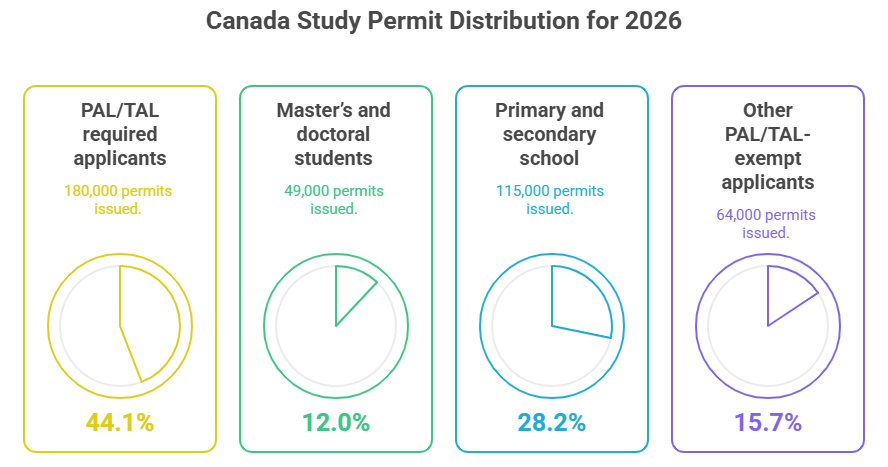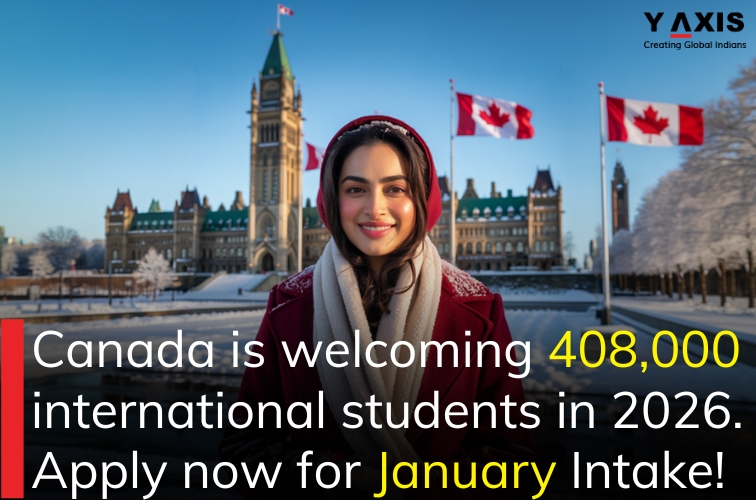Posted on November 26 2025
Canada is welcoming 408,000 students in 2026. Apply now!
By , Editor
Updated November 26 2025
Highlights: Canada Announces Study Permit Allocation for 2026
- Canada has officially set its study permit cap for 2026, outlining clear allocations for new applicants and extensions under its long-term immigration plan.
- A total of 408,000 study permits will be issued in 2026 across all student categories.
- 155,000 permits are earmarked exclusively for newly arriving international students.
- 253,000 permits will go to extensions for in-Canada students who are continuing or returning to their studies.
- 180,000 permits are dedicated to PAL/TAL-required applicants, while 49,000 spots are reserved for master’s and PhD students who are exempt from PAL/TAL.
*Want to apply for a Canada student visa? Let Y-Axis guide you with the steps.
Canada Reveals How 408,000 Study Permits Will Be Distributed in 2026
Canada has released a detailed breakdown of how the 408,000 study permits for 2026 will be distributed across different student categories.

The detailed breakdown given below shows how Canada will prioritise different student groups in 2026, from postgraduate applicants to K–12 students and PAL/TAL-exempt streams.
|
Type of candidates (both new arrivals and in-Canada extensions) |
Number of permits issued |
|
PAL/ TAL required applicants |
1,80,000 |
|
Master’s and doctoral students (PAL/TAL exempt) |
49,000 |
|
Primary and secondary school (kindergarten to grade 12, also PAL/TAL exempt) |
1,15,000 |
|
Other PAL/TAL-exempt study permit applicants |
64,000 |
|
Total |
4,08,000 |
PAL/TAL Requirements for 2026
Canada has revised the PAL/TAL rules that will come into effect from January 2026. These changes determine which applicants require additional attestation to apply for a study permit.
Key points include:
- Master’s and doctoral students will no longer need to obtain a provincial or territorial attestation letter.
- Most other post-secondary applicants, including undergraduate and diploma students, will be required to submit a PAL/TAL.
- Exemptions apply to minor students and certain specialised programs.
- The purpose of the PAL/TAL system is to help provinces manage international student numbers based on educational capacity and infrastructure.
*Want to study in Canada? Sign up with Y-Axis to guide you with the process.
Province-Wise Allocation of Study Permits for 2026 Announced by Canada
Along with the category-wise distribution, Canada has also confirmed how PAL/TAL-required study permits will be distributed across provinces and territories in 2026. This allocation helps students understand which regions will have higher approval opportunities and where competition may be stronger.
IRCC will process up to 309,670 applications from PAL/TAL-required students in 2026, which is expected to result in up to 180,000 approved study permits. These allocations are based on provincial population and educational capacity.
Province-Wise Study Permit Allocation for PAL/TAL-Required Cohorts (2026):
|
Province/Territory |
Applications to Be Processed |
Expected Approvals |
|
Alberta |
32,271 |
21,582 |
|
British Columbia |
32,596 |
24,786 |
|
Manitoba |
11,196 |
6,534 |
|
New Brunswick |
8,004 |
3,726 |
|
Newfoundland & Labrador |
5,507 |
2,358 |
|
Northwest Territories |
785 |
198 |
|
Nova Scotia |
8,480 |
4,680 |
|
Nunavut |
0 |
180 |
|
Ontario |
1,04,780 |
70,074 |
|
Prince Edward Island |
1,376 |
774 |
|
Quebec |
93,069 |
39,474 |
|
Saskatchewan |
11,349 |
5,436 |
|
Yukon |
257 |
198 |
|
Total |
3,09,670 |
1,80,000 |
Also, read…
Canada Introduces Revised Rules for Visitor, Student & Work Visas. Check your eligibility!
What the 2026 Study Permit Plan Means for Indian Students
Canada’s revised study permit cap and provincial allocations for 2026 bring both opportunities and new requirements for Indian students. With clear category-wise and province-wise limits now published, students can plan their applications more strategically and align with programs that match Canada’s updated guidelines.

Key Points for Indian Students:
- Master’s and PhD applicants gain a major advantage, as they no longer require a PAL/TAL from January 2026, making their study permit process faster and simpler.
- Undergraduate, diploma, and college applicants will need a PAL/TAL, so applying early is crucial due to limited provincial allocations and higher competition in popular provinces.
- Choosing the right province becomes more important, with higher competition expected in Ontario, British Columbia, and Quebec. Students may find easier entry and faster processing in provinces like Nova Scotia, Manitoba, Saskatchewan, and New Brunswick.
- Students already in Canada benefit from stability, with 253,000 study permits reserved for extensions, ensuring smoother continuation of studies or transitions to higher programs.
- The updated 2026 allocation brings more transparency, helping Indian students plan better, understand documentation requirements clearly, and align with provinces and programs that match their goals.
*Are you looking for step-by-step assistance with Canadian immigration? Contact Y-Axis, the world’s No. 1 overseas immigration consultancy!
For recent Canadian immigration updates, check out Y-Axis Canada immigration News!
FAQs
What is the new Canada study permit cap announced for 2026?
Canada’s 2026 study permit cap sets a fixed national limit on the number of new international student permits that can be issued that year. This cap is part of the government’s strategy to stabilize the international education system, ensure housing capacity, and manage pressures on public services. The cap will be divided among provinces and territories, with each region receiving an allocation based on population, infrastructure, and previous enrolment levels. While the exact number may vary depending on policy updates, the cap aims to bring predictability and balance to Canada’s rapidly expanding student intake.
Why did Canada introduce a study permit cap for 2026?
Canada introduced the 2026 study permit cap to manage the sharp growth in international student arrivals and address concerns around housing shortages, institutional quality, and program integrity. The government aims to ensure that colleges and universities can support incoming students with adequate accommodation, resources, and student services. The cap is also designed to curb the rise of low-quality programs and ensure that education providers meet stronger standards. By implementing this limit, Canada hopes to create a more sustainable and transparent framework that protects students’ interests while easing pressure on local communities.
How will the 2026 study permit cap affect international students?
The 2026 study permit cap means that fewer study permits may be available compared to previous years, making the application process more competitive. Students may need to submit stronger documentation, secure admission earlier, and meet higher eligibility standards set by their province. Some provinces with high demand may receive smaller allocations, affecting acceptance rates. However, the cap aims to ensure better-quality programs, improved student support, and more reliable pathways to housing and settlement. Students who prepare early and choose reputable institutions may still have strong chances of approval under the new system.
Will the 2026 cap reduce the number of study permits issued to Indians?
India is Canada’s largest source of international students, so the 2026 cap may influence the overall number of approved applications from Indian students. However, the reduction is not specific to any nationality; it applies to all applicants globally. Approval will depend on provincial allocations, the quality of the program, and the completeness of the student’s application. Indian students applying to public universities, high-quality colleges, and priority programs may still have good chances of securing study permits. Early planning and meeting all documentation requirements will be crucial under the new cap system.
How will provinces and territories be impacted by the 2026 study permit limit?
Provinces and territories will receive their own study permit allocations, which may affect how many students local institutions can admit. High-demand provinces, such as Ontario and British Columbia, may face stricter limits, while regions with more capacity may receive larger shares. The cap will push institutions to improve infrastructure, regulate program quality, and ensure adequate housing for incoming students. Provincial governments will also play a more active role in issuing attestation letters and monitoring compliance. These measures aim to balance enrolment numbers with available resources and long-term economic needs.
Does the 2026 study permit cap affect postgraduate work permit (PGWP) eligibility?
The 2026 study permit cap itself does not directly change PGWP rules, but it may influence which institutions students choose. Since only students enrolled in eligible public institutions can qualify for a PGWP, the cap may encourage students to prioritize programs with clear immigration pathways. Universities and public colleges are expected to remain safe options for PGWP eligibility, while some private programs may face stricter scrutiny. Students who secure study permits under the cap and meet all program conditions will still be able to apply for the PGWP after completing their studies.
Will current international students be impacted by the 2026 cap?
Current international students already in Canada are not directly affected by the 2026 study permit cap. The cap applies only to new study permit applications for the 2026 intake period. Students already enrolled in programs, holding valid permits, or applying for extensions will continue under the existing rules. However, the cap may influence institutional funding, program availability, and housing demand, which could indirectly affect the student experience. Overall, the primary goal is to stabilize future enrolment, not disrupt the studies of current international students.
How will Canada decide which students receive study permits under the 2026 limit?
Student selection under the 2026 cap will depend on provincial allocations, institutional eligibility, program quality, and the applicant’s academic strength. Priority may be given to students enrolling in programs that align with labour needs, such as healthcare, STEM, trades, and advanced research fields. Strong applications with complete documentation, proof of funds, and genuine study intent will have higher chances of approval. Provinces will issue attestation letters, and institutions may limit admissions to match their regional cap. The process aims to ensure fairness, transparency, and alignment with Canada’s economic goals.
Are any student categories exempt from the 2026 study permit cap?
Certain categories may be exempt from the 2026 cap, depending on policy updates. Typically, exemptions may include graduate-level students, those pursuing master's or PhD programs, exchange students, and dependents of temporary residents already in Canada. Some programs deemed essential to labour market needs may also receive special consideration. The goal of exemptions is to ensure Canada continues attracting high-level talent and students with strong long-term immigration potential. Students planning higher studies may still benefit from flexible rules even under the capped system.
What should students do to improve their chances of getting a study permit in 2026?
Students can improve their chances by applying early, choosing reputable public institutions, and securing admission to high-quality programs aligned with Canada’s labour market needs. Preparing strong financial documents, writing a clear statement of purpose, and demonstrating genuine study intent are essential. Students should also stay informed about provincial attestation requirements and ensure their application is complete and error-free. Working with trusted advisors, strengthening language scores, and avoiding low-quality institutions can significantly increase approval chances under the competitive 2026 study permit cap.
Tags:
Canada immigration news
Migrate to Canada
Canada student visa
Canada study permit
Study in Canada
Canada study permit 2026
Canada visas
Canada student visa for Indians
Canada PR
Share
Options for you by Y-Axis
Get it on your mobile
Get News alerts
Contact Y-Axis

